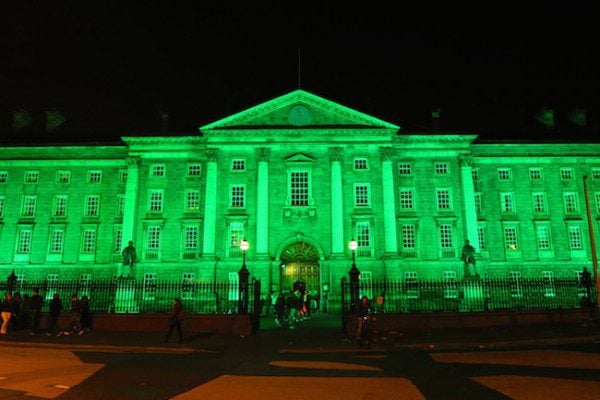Going Underground to the Catacombs of Paris
The lowest place in Paris, both literally and spiritually, visiting the Catacombs of Paris will leave you with a lasting impression. They say Paris is like Swiss cheese, with hundreds of kilometers of tunnels criss crossing in all directions and when you head 65 meters below ground, you start to know what all the fuss is about. Cafe dwellers in the classic Montparnasse cafes have no idea what’s happening right beneath their feet, while they’re sipping their morning lattes. Only 200 people are permitted to be down in the famous underground graveyard – anything above this, starts to trigger supernatural freaky stuff that you don’t want to be anywhere close to! Just kidding of course. This guide covers how to best visit the Catacombs of Paris.
Heading to Paris?
Plan the perfect trip to Paris with free and in-depth Paris travel guides, including the Best of Paris collection and a guide to all major Parisian neighborhoods.
Like every other visitor to Paris, I’ve gone underground on a daily basis, getting around town on the fabulous Metro. I’ve gone even further in my exploration of underground Paris with a visit to the Paris Sewer System Museum. Visiting the Catacombs was the culminating event in an underground Paris adventure. Are you ready?
Why Visit the Paris Catacombs?
This is really a no-brainer! Visiting the Catacombs of Paris has to be one of the most unique things to do in Paris and probably in your entire lifetime. First of all, it’s incredibly interesting to head below ground in a city that’s been around for so many centuries and to understand how these tunnels came to be. Second, where else can you get up close and personal with a massive underground cemetery? Sure, it’s super creepy and quite weird to see all those human remains – but visiting the Catacombs should not be missed.
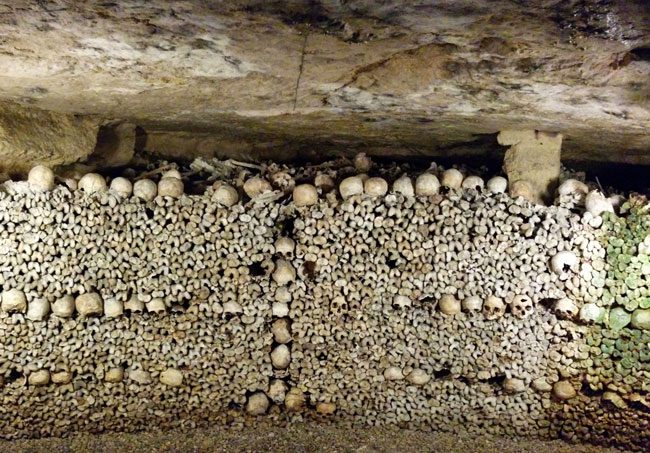
The Story Behind the Paris Catacombs
The present state of the Catacombs is the result of a series of events. Let’s start from the beginning.
Ancient Times
It all started about 45 million years ago in the Lutetian Period. The dinosaurs have been gone for 20 million years, and the area of present-day Paris is covered in a warm, tropical ancient sea. These warm waters are rich with plants and fish that form a massive layer of limestone when the sea vanishes.
On came the Romans who began to develop a small town called Lutetia, which would later become Paris! To build their town, the Romans need raw materials, and they don’t have to look any further than the hillside – abundant with prime limestone. When the hillsides aren’t enough, the Romans go underground, extracting the limestone and creating small underground quarries.
Paris is Born
On come the Franks, busy expanding their flagship city – Paris! With newer quarrying techniques, more and more rock is taken out of the ground. It is of such good quality that it becomes known as Paris Stone. The Louvre, Notre Dame & the Latin Quarter can all thank the underground quarries for giving them life. By the 18th and 19th centuries, over 300 km of underground quarries snaked their way beneath the expanding city. By now, the tunnels are no longer on the outskirts of town but right beneath Parisian neighborhoods. Centuries of quarrying leave a labyrinth of tunnels beneath the city, unmapped and unregulated in any way.
In the mid-18th century, things started to go wrong as entire city blocks began to plummet into underground caverns. Panic spreads throughout Paris!
Underground Real Estate
On comes the King! King Louis XIV, that is. In 1777 he decided to set up a royal commission to map out the quarries and strengthen tunnels where needed. The Inspection Générale des Carrières (IGC) is formed, and men begin the tedious and dangerous task of saving Paris from its ancient tunnels, digging new access tunnels to reach the toughest spots.
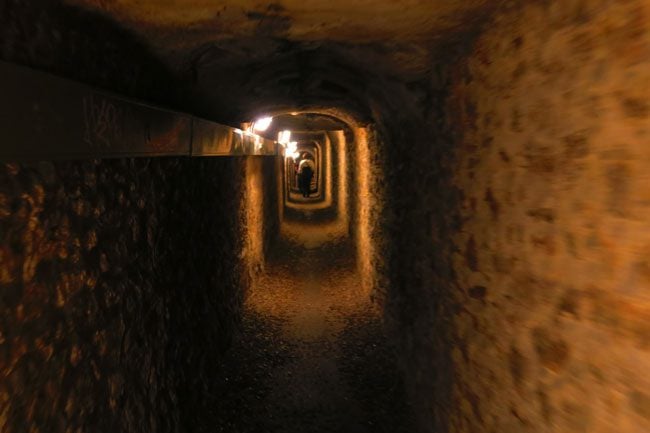
Mapping the underground tunnels sparks another idea in the King’s mind, as he is facing unrest from the people of Paris. You see, Paris of the late 18th century is a filthy place with sewage running in the streets, freshwater contaminated and the cemeteries overflowing. There is simply no more room to bury the dead, especially in the big cemetery in the center of town, in what is now Les Halles. Centuries of human settlement, wars, and plagues – have rendered the cemeteries completely full and the stench is unbearable!
The king orders the cemeteries to be emptied out and moved underground where real estate is plentiful and now partially mapped! Until 1859, it is estimated that 7 million bodies are exhumed and transferred below ground, from more than 150 cemeteries. Centuries of deceased Parisians are piled into the old quarries. Legend has it that one undertaker counted 70,000 bodies that he alone transferred underground.
In the years after the French Revolution, the city decided to clean up the underground graves, opening them up for both mourners and visitors. The millions of bones and skulls are neatly rearranged to make the place look ‘nicer’. The tunnels not used for burial are also used for mushroom cultivation (champignon de Paris), brewing beer, and distilling spirits!
The Cataphiles
Today, we can only visit a tiny section of the underground maze. Much of the underground system is still left unmapped or has been changed by the elements, with some tunnels collapsing or filling up with water. That hasn’t stopped the Parisian romanticism of the Catacombs and heading underground became a kind of a right of passage for many Parisians by the mid 20th century. The party ended in 1955 with the city banning rogue visits to the tunnels and actually sealing up most of the known entrances while concealing others.
On come the Cataphiles! These clandestine groups don’t take no for an answer. Over the years, stories emerge of these folks throwing secret parties in massive underground chambers, decorated with lavish art and fitted with limestone seating areas. There are also rumors of underground cinemas and stories of people venturing underground and… never making it back!
- The Paris Catacombs are open every day but Monday from 10 am – 8 pm and last admission is at 7 pm.
- You can now purchase in advance skip-the-line tickets to the Catacombs of Paris. Although it comes with a premium, considering the wait in line and the possibility of not even getting in, it might be a wise decision.
- There can only be a maximum of 200 people inside the tunnels at any given time and there is a perpetual queue at the entrance throughout the day. If you don’t want to wait hours in line (and I mean hours) or buy your ticket in advance, get here at the very least 45 minutes before opening. This is the biggest tip when it comes to visiting the Catacombs.
- The temperature down in the Catacombs is a constant 14 degrees and it can be a bit damp down there. Dress accordingly with a few layers and proper shoes.
- Getting to the Paris Catacombs is super easy by Metro. Simply get off at the Denfert-Rochereau and you’ll exit right at the entrance.
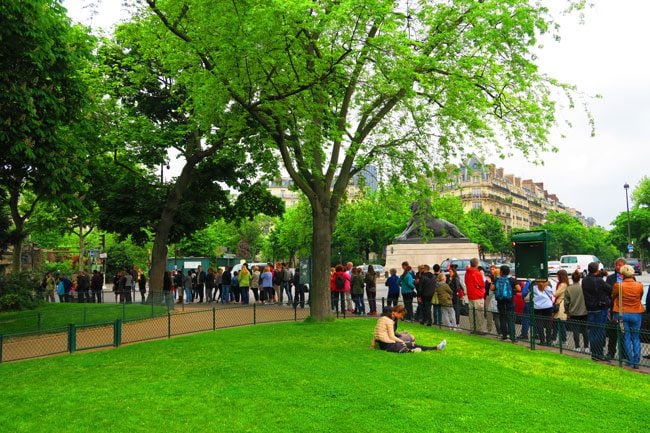
How Long Do You Need at the Paris Catacombs?
The 2-kilometer underground journey lasts about 1 hour and that’s just about the point where claustrophobia starts to kick in.
You can combine your visit to the Catacombs of Paris with exploring Montparnasse, a Parisian neighborhood famous for its cinemas, brasseries and cafes. Montparnasse was the home of artists and writers throughout the early part of the 20th century. The area is just south of the posh, yet unmissable Saint Germain and the Luxembourg Garden – so there’s plenty to see after you emerge from underground.
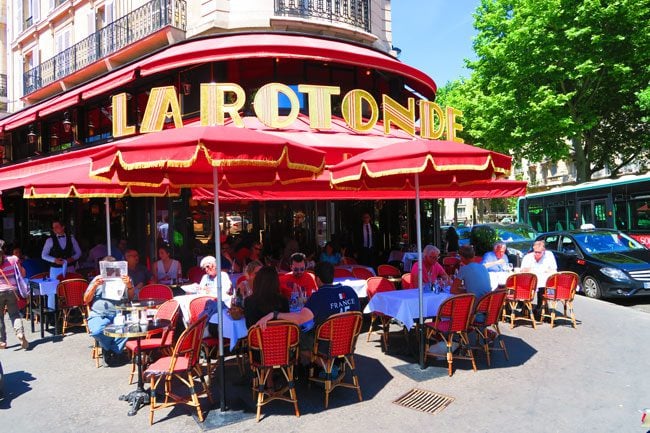
What to See at the Paris Catacombs?
It all starts with a 130 step descent 65 meters below ground. You are well below the Metro lines and the sewage system. You then begin to walk through access tunnels dug by the Inspection Générale des Carrières (IGC) in their mapping efforts of the quarries.
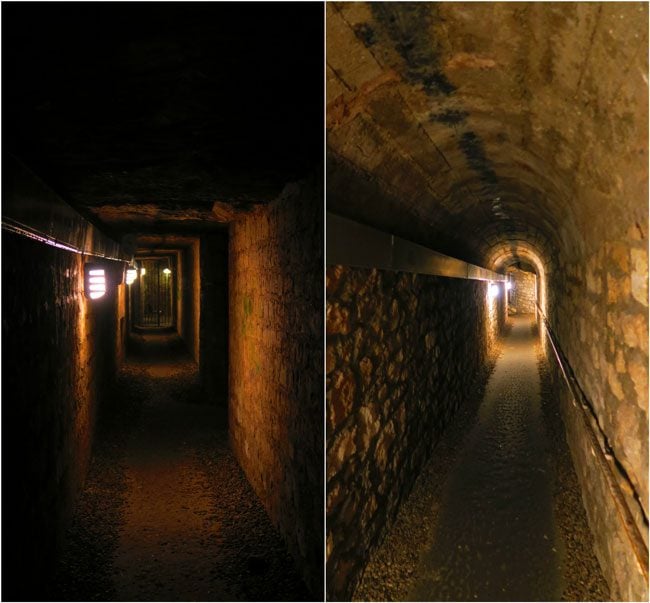
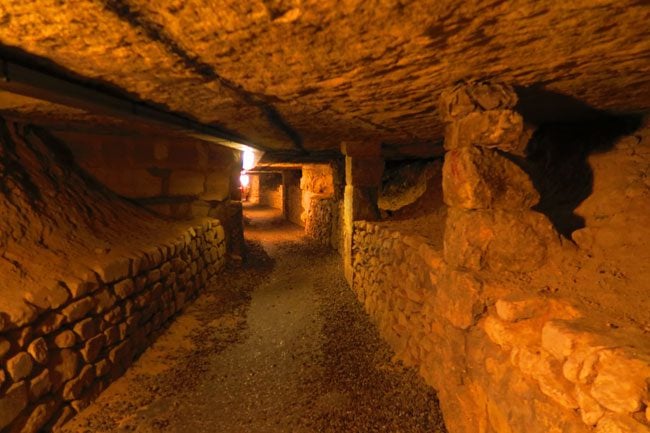
From time to time, you’ll see inscriptions that the IGC crews left behind with their names and the names of the streets above them. Just imagine what it would be like down here without the lighting. Super scary!
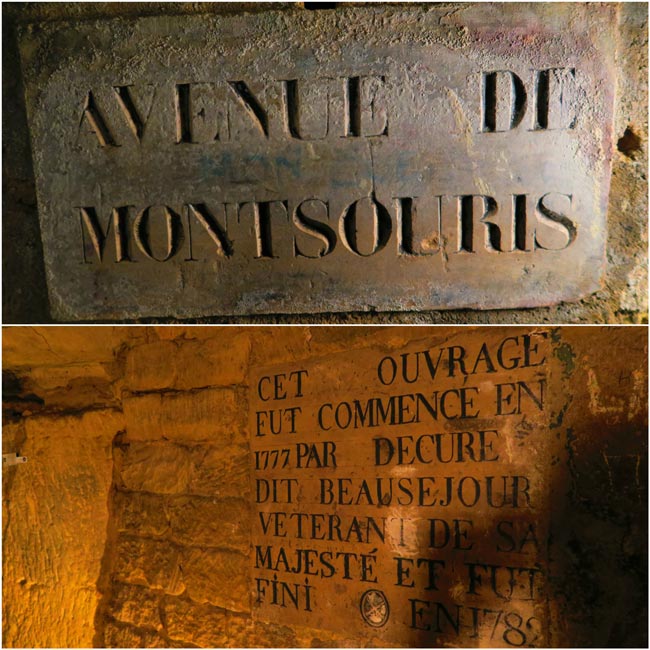
Before we reach the graveyard, there are a few interesting highlights along the way. The first is the ‘Port Mahon Sculptures’ – a replica of the Port Mahon Palace in Minorca, Spain. This out-of-place work of art was sculpted from memory by one of the earliest IGC workers who was actually killed not too far from this spot while working on an access tunnel.
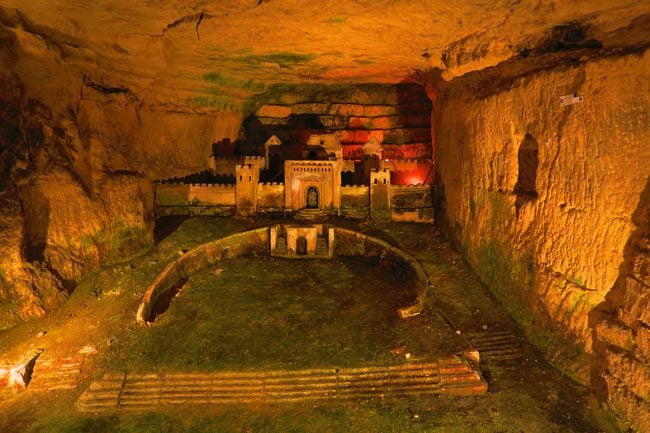
The second highlight is an underground well that was discovered down here. The water is super turquoise and who knows how deep and how far this stream goes.
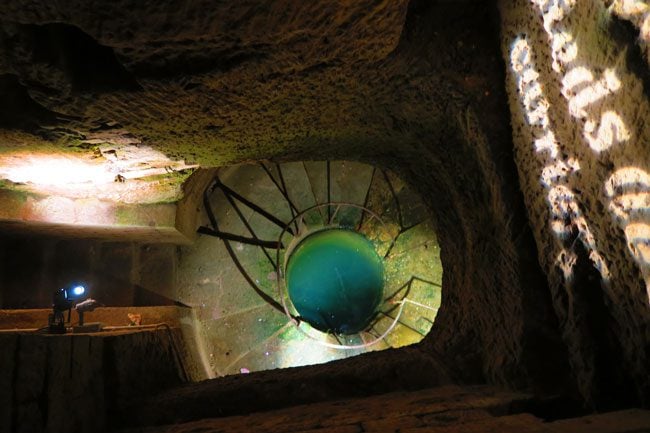
Before you know it, you are faced with an unmissable sign: Arrête! C’est ici l’empire de la Mort (“Stop! This is the Empire of the Dead”). Welcome to the Catacombs of Paris!
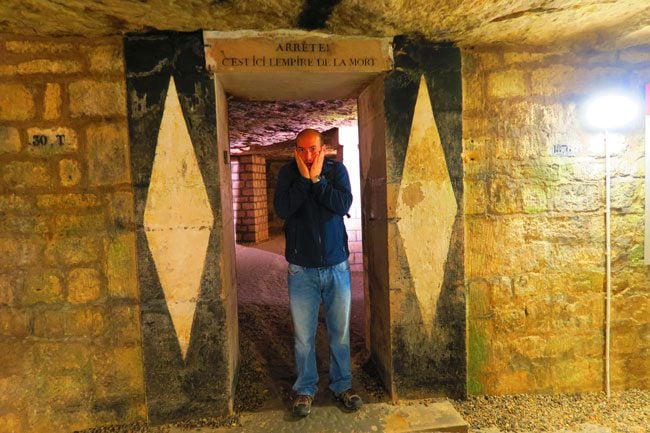
What happens next has to be one of the most chilling moments of your life yet at the same time the most thrilling. You are now walking along parts of the tunnels that were used to house the remains of deceased Parisians. The sight is unbelievable: piles and piles of bones and skulls are neatly stacked on one another up to shoulder height and at least 2 meters deep.
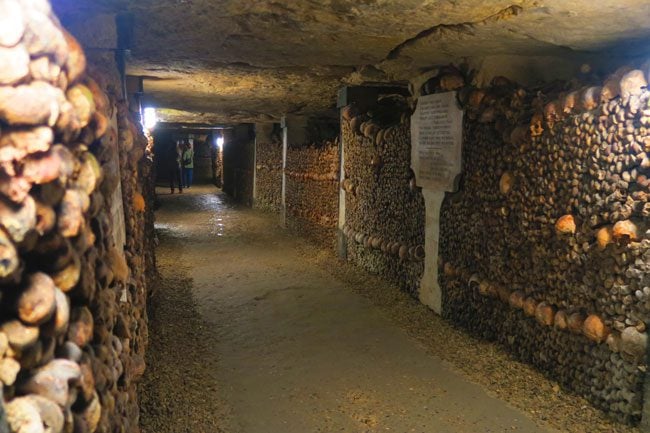
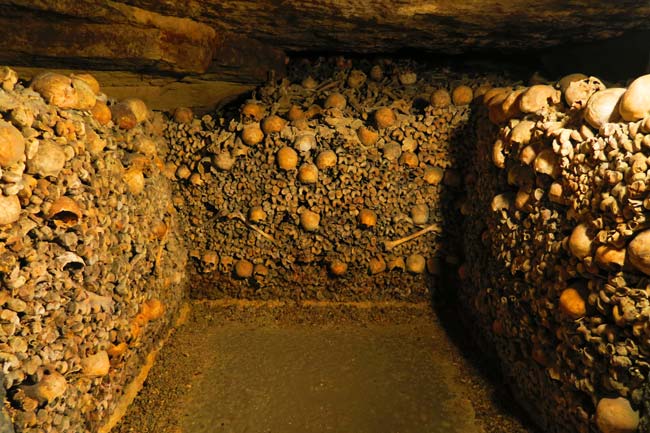

You can get up close and personal with what’s left of the deceased – just don’t touch anything!

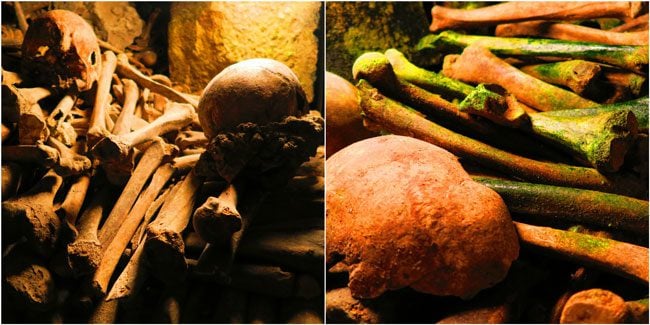
As I’ve mentioned earlier, work was done post-French Revolution to make the Catacombs more accessible and look nicer. The result is what I would call ‘morbid art’ – bones and skulls piled to form heart shapes and neat columns! What do you think the folks who arranged this were thinking about?

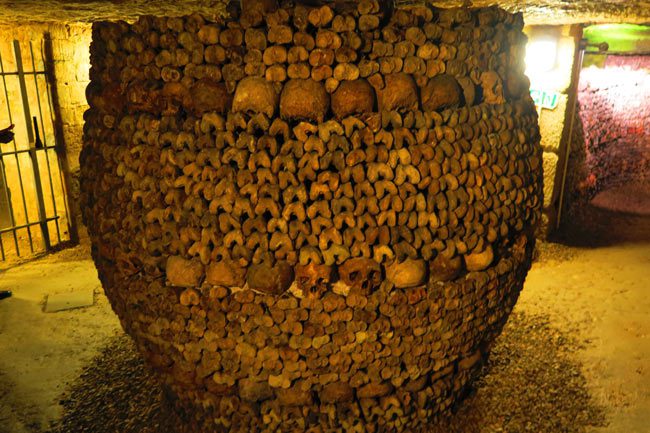
Here and there, you’ll come across a few chambers that were put in place as prayer rooms. You’ll also see signs indicating the exact cemetery that was relocated to this very spot and the date at which the remains were shipped below ground.
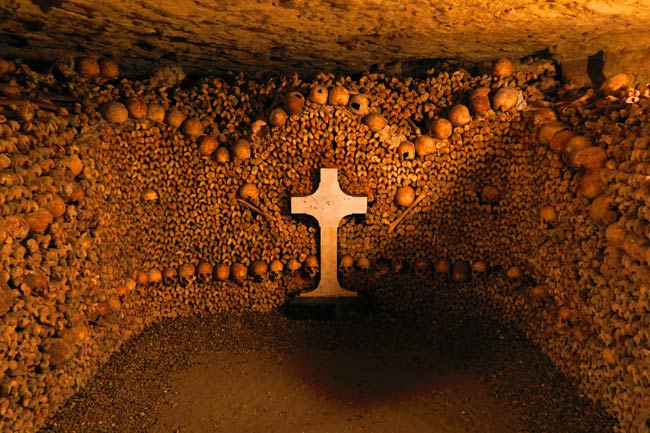
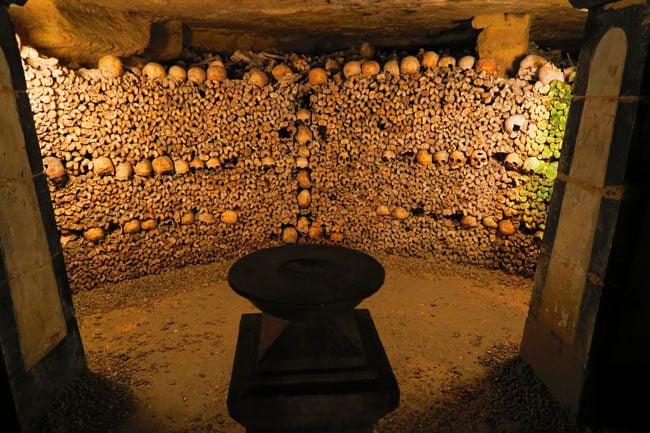
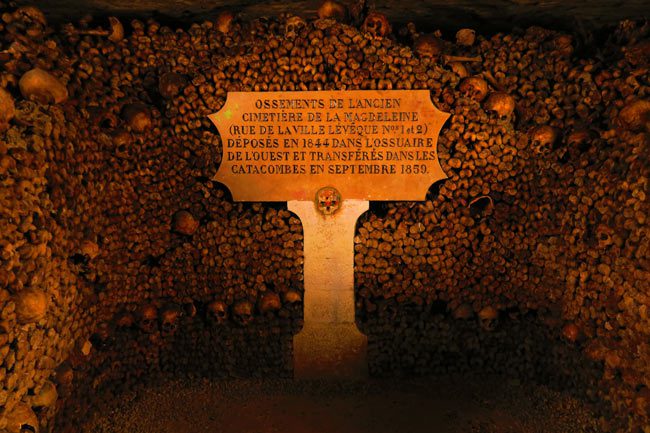
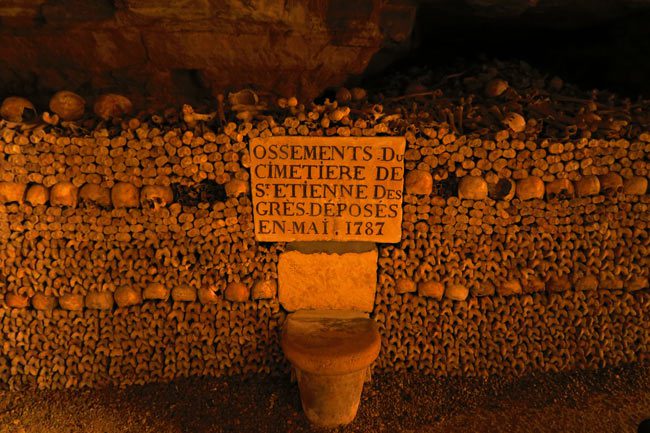
After about an hour of walking below ground, you slowly begin heading back up. I must say that it felt very good to get some fresh air!
In Conclusion
I definitely don’t want to be left down here at night but visiting the Paris Catacombs has to be one of the top things to do in Paris. I am super glad we got here early in the morning and actually think we should have gotten here a bit sooner. If this isn’t your first time to Paris or you have plenty of time to see the top sights – do plan a trip to the Catacombs. Visiting the Catacombs is both chilling and super cool. I feel a great sense of achievement coming down here and completing my exploration of underground Paris, having visited the Paris Sewer System Museum, riding the metro, and now visiting this unique underground cemetery!
What’s Next?
Plan the perfect trip to Paris with free and in-depth Paris travel guides, including the Best of Paris collection and a guide to all major Parisian neighborhoods.







